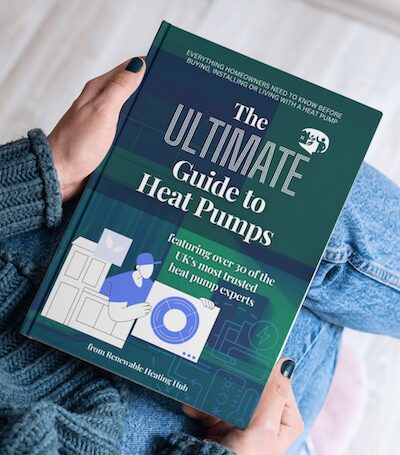Hi Adam. Ooh that's good news, I'm sure I'll be asking more !
I have got a LAN adapter with an ethernet connection to my wi-fi router, and the Daikin Residential Controller app on my phone. I'd hoped it would have more info than the indoor unit control screen but unfortunately it's not as detailed, eg the hours running and flow temps aren't on there (at least I haven't found them yet). The thermostat can be nudged up or down from the app, powerful operation can be switched on (ie the immersion), I can see the energy usage over the last 48 hours for heating and tank, also scheduling can be done on the app, which is much easier than the controller screen.
However, from reading on this forum I've now set it to run 24/7 at 21 deg C, which is working well so far (and more or less how the installers initially left it). The house is warm !!! I didn't switch it off when we went away last weekend but I closed all the curtains and shut all the internal doors; everything stayed cosy and the heating ran as and when it needed to. That goes against Rob Whitney's video interview when he talked about switching the heating off when the house is empty, that doesn't seem to be appropriate with the heat pump.
I assume the back up heater is much like an immersion heater inside the indoor controller ? Do you know how powerful it is ?
So, just because I'm an ancientbie you have cast me aside for the young Adam. 😥 My crest has definitely fallen. 😫
Be careful Adam, she uses SMOKE and Mirrors. 🙃
Posted by: @adam-cHi Newbie,
I have the same system as you and can confirm what was said above.
Seeing as Daikin claim the heat pump works down to -25c I really do not understand why the backup heater would ever be needed in the UK except as the result of a failure.
Any questions please feel free as I have had to learn this interface as it was not very well set up initially.
Do you have access to the system on your phone through the Daikin App? I have just ordered a LAN access box as it was not installed originally and really want more data than what is available on the little screen.
Cheers,
Adam
Whilst that is true @editor made an excellent point in my Daikin thread.
"If running bivalent and your objective is to save money you may wish to let gas heat your central heating below 3-4°C when heat pump efficiency starts to drop off and defrost cycles are more common."
I am trialling setting the default of -4°C to 5°C.
There is a couple of different options for the backup heater element. It should be written on the paperwork given to you by the installer... Mines a 9kw 3phase but doubt yours is 3 phase as very uncommon in houses.
Shame about the limited data on the App. I'll see what I can get out of it when I install it. Do you have any idea if you have a energy meter installed with it. Its an option and I will add one to my switchboard but not sure what extra benefits you get as the unit monitors its own usage as far as I can see.
We go away quite a lot and if its more than 3 days I turn the house temps down to about 17, but have to remember to turn them back up at least 24 hours before we are scheduled to return. Just did a week away and significantly less energy draw so I think its better that way.
@DerekM
Thanks for the warning 😉 but I will definitely defer to your superior knowledge.
@adaml Yes that is a very good point about using gas if you have a bivalent at low temps.
But using a resistive element that's built into a unit rather than a heat pump at very low temps even with a COP of say 2, that's still twice the efficiency of the resistive element.
Anyone will be able to confirm this one:
On the 'split' system the compressor is in the outdoor unit, and both the pump and the heat exchanger are in the indoor unit.
Posted by: @heat-pump-newbieAnyone will be able to confirm this one:
On the 'split' system the compressor is in the outdoor unit, and both the pump and the heat exchanger are in the indoor unit.
You are indeed correct.
It depends on the model.
All compressors will be outside. But on my model the heat exchanger (evaporator is the correct refrigerant term) is outside as this is where the heat from the refrigerant is transferred to the water. The water is then circulated to the indoor unit with a pump indoors.
But they also do units where the refrigerant is piped indoors to a indoor unit and the heat exchanger is inside.
But... Daikin now do a unit where even the pump is outside.
If you can find the exact model number from your outdoor unit I should be able to tell you your setup.
EDIT: Link does not seem to work so just google, Daikin altherma 3 monoblock r32
Hi @adam-c
You are correct Adam, I should have been more precise. There are in fact two heat exchangers, the condenser and the evaporator.
The evaporator will always be located in the outside unit, since this is where the liquid refrigerant gas is evaporated back into a gas, by absorbing energy from the outside air. In a split system the condenser will be in the indoor unit, and is where the hot refrigerant gas heats the primary circuit water, and in so doing the refrigerant gas is condensed into a liquid.
I have a new What's it all about? question for you.
I believe the difference in temperature (is it the hysteresis ?) between the Leaving water and the Inlet water is set in the system - mine seems to be about 7 deg when it's running the heating, and 4 deg when it's running the DHW.
So my question is: how does this work ? Is it done by the flow rate of the water being pumped round the system ? I can't see the flow rate on my controller (at least I don't know how to).
Hi @derek-m and everyone. Can I re-ask the hysteresis / flow question again as it's got buried under the recent other stuff !
I'm not sure that difference is 'set', but it's essentially the properties of your heat emitters (radiators, UFH etc) and water cylinder.
For example, you emit water at one temperature into your radiator loop. The amount of flow depends on the pressure (set by the pump) but also the amount of resistance. For example if all the radiator valves are open the water flows through all your radiators. Let's say your house is freezing cold. Lots of hot water is flowing into your radiators, and as it goes through it cools down, dumping that heat into the house. That water comes back to the heat pump inlet quite cold.
Then another example might be when it's quite warm inside and most of the radiator valves are turned off (eg you have TRVs). The pressure is the same, but only one radiator is turned on so the flow is much less. The water goes through the one radiator, but the room is warm, the water is warm too, so not much heat is dumped into the room and the water comes back still fairly warm.
In DHW you don't have radiators you have a coil in the hot water cylinder, but it's the same idea. Cold tank of water, most of the heat goes into the water. Almost hot tank, almost no heat goes in. The difference starts off big and then gets smaller as the tank warms up.
Was that what you meant, or was it something else? (I don't know your particular unit)
Thanks @prunus - it's a Daikin split low temp EHBH08EA6V indoors ERGA06EAV3 outdoors. That does make sense, but when the pump is running the difference in flow and return temps always seems to be around 7 deg for heating regardless. All the radiator valves are fully open.
- 26 Forums
- 2,342 Topics
- 53 K Posts
- 224 Online
- 6,000 Members
Join Us!
Worth Watching
Latest Posts
-

RE: Has Anyone Else Noticed a Decline in Tradesmanship?
My own experience has always been that 'bringing in the...
By cathodeRay , 2 hours ago
-

I have just had a new solar array and batteries install...
By TechnoGeek , 2 hours ago
-

RE: Configuration issues with 10kW Midea R32 heat pump
You need to set the one shown in the photo you posted t...
By cathodeRay , 3 hours ago
-
RE: Poll for Time of Use, tariffs, technology
I ticked Intelligent and Agile, I'm on Agile at the mom...
By JohnnyB , 9 hours ago
-

RE: What a Bad Heat Pump Installation Looks Like
@editor The trick to an inside unit installation is to ...
By MikeFl , 12 hours ago
-
RE: Different dT on each radiator?
The way heating systems are designed will result in rou...
By JamesPa , 14 hours ago
-

RE: Setback savings - fact or fiction?
PS by visually merging the two tables as above, I ended...
By cathodeRay , 24 hours ago
-

RE: Homely for Daikin Altherma 3 - Petersfield Area
@russ If you would care to pose your questions on one o...
By Toodles , 1 day ago
-

RE: A Smarter Smart Controller from Homely?
@papahuhu I have a feeling that my Homely smart control...
By Toodles , 1 day ago
-

RE: The good, the bad and the not that great – my heat pump installation
@cathoderay the guy I spoke to on the phone seemed very...
By Burtis , 1 day ago
-
RE: British Gas vs Octopus Energy vs Heat Geek vs EDF vs Aira vs OVO vs EON.Next vs Boxt
I get the impression that that comment "they don't comm...
By JamesPa , 2 days ago
-

@majordennisbloodnok Just in case there are variations ...
By Toodles , 2 days ago
-

RE: Latest NIBE model has known defect and no solution
@kings I’m glad I could help. NIBE are taking this very...
By Mars , 2 days ago
-
RE: Octopus Cosy Heat Pump Owners & Discussion Thread
@jamespa yes, I'm under no illusions but in some respec...
By AndrewJ , 2 days ago
-
RE: Electricity price predictions
It seems the end of cfd payments is in sight, even if a...
By Batpred , 2 days ago
-
-
@pie_eater Yes, I installed Homely to a Daikin heat pum...
By gery , 3 days ago
-
RE: Havenwise App Help & Forum Support – Get the Most from Your Heat Pump
@davidalgarve Potentially stupid question, but are you ...
By Sheriff Fatman , 3 days ago
-
RE: Replacing my 18 month old Hitachi Yutaki ASHP
@trebor12345 Ok that makes more sense and leads is i...
By JamesPa , 3 days ago





